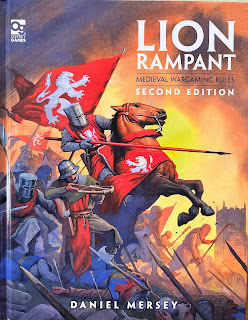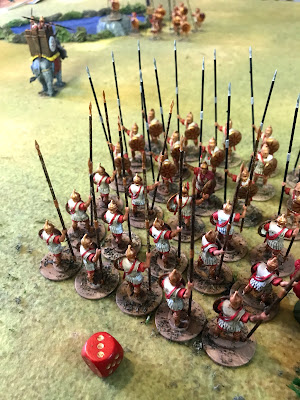Well, well, well... another book from Osprey and another one in the Rampant series by Daniel Mersey. The two big powerhouses of the Osprey publishing universe are Joseph A. McCullough and Daniel Mersey. Of course, we all know that Mr. Mersey wrote the very first in the Osprey Wargaming Series; Dux Bellorum. He then went on to write Lion Rampant which was a break out hit for Osprey and one of their most popular titles. Since then, he "Co-lab"ed (as the kids say) with a variety of writer's to release various versions of the "Rampant" series titles such as Dragon Rampant, The Men Who Would Be Kings, Pikeman's Lament, Rebels and Patriots, and Xenos Rampant. He also released a variety of supplemental content for Lion Rampant such as A Viking in the Sun and Crusader States. The "Rampant Series" was so popular there are also a number of boot-leg versions out there including for Chariot Wars, Napoleonics, Ancients, and probably more. Plus, Daniel Mersey has created a number of other non-Osprey games to boot. He is now the Wargame Designer in Residence at Edinburgh college. Needless to say, he is one of my big inspirations and I am always interested in what he is putting out into the world.
As you can tell from the list of links I put in above, that I have Lion Rampant from the original Blue Book series. So, why did I spend the money on this version? The original one is still a very serviceable set of rules! Well, I have some Dark Age armies, and Vikings, and I love me some Mersey game design... so I bought these.
So, since I have all ready reviewed the main Lion Rampant rules, I figured I would avoid most of the talk about how the game plays, and instead just focus on what I found that was new and interesting. So, let's us don our armor, grab our lance, and parade out onto the field of battle.....
Things That I Liked
Instead of rolling for Leader Traits randomly, you can purchase them. In addition, all leaders get the old Commanding trait. That means if you are within 12" of the leader and fail an activation roll you can re-roll it once.
Giving this re-roll to all Leaders in the game off-sets one of the strongest criticisms of the Lion Rampant rules; the Activation Roll. However, if you fail an activation roll you still turn play over to your rival, but with careful use of your leader you can probably get the units you want to do stuff, doing stuff. It keeps the element of "friction" that your units do not always act as intended but provides a way to mitigate the danger with player choice.
They add some rules for adding priests and banners to units to help fill in points. They give you +1 command, but if they are killed you cede 1 Glory to the foe.
Some units were given an option for mixed weapons. This tracks with what I have read historically about many units of the period. They had a variety of weapons including ranged and close. I am glad this option was added.
The rules add an optional Strength Point model which is used in the other "Rampant" systems. Therefore, you could scale down your games even further if you wanted. I.e. the Leader could be a single model.
Things That I Did Not Like
There are several pages of Sample 24 point warbands from a variety of historical periods, which is awesome! On the downside, they are not army lists. Instead, they refer you back to the other publications that the samples are taken from. Considering this is one of the main reasons I picked up the 2nd edition was for some expanded army lists and historical blurbs for various periods I was greatly disappointed by this development. So disappointed, I am resorting to this emoji :(
There is also a less interesting "alternative" activation rules where if you fail an Activation Test, play does not turn over to the other player. Only that unit is impacted. They used this method in some of the later "Rampant" series of games but I find it less interesting. However, it is exactly what many players were asking for. However, this changes the game a lot as it moves from being a Push Your Luck game into an IGOUGO game. I find this alternate rule..... less than exciting. It might work better in larger games around 36+ points, and that is what the author recommends.
The rules talk about how to play with multiple players, but does not really cover co-op or solo play. This is a big oversight in modern wargames. With a 190+ page book, there was room to add some. Afterall, The Men Who Would Be Kings has a template for solo rules that could have been incorporated into these rules.
Meh and Other Uncertainties
The rules seem to be interested in scaling the game up and down from the original 24 point, unit-vs-unit skirmish scale. Therefore, there are a number of optional rules that cover how to deal with these different size forces. This includes ways to perform group moves or more than one unit at a time. Clearly, this is intended for the larger size battles.
There are Shieldwall rules in here, so you can have Viking Age battles. Woot! Woot! This game also adds some other unit types like Camels, Chariots, Pikeman, hand gonnes, and extra flighty light troops.
The game has a much more detailed discussion of terrain. One of the things I liked about the original version of the rules, was that Terrain was so abstracted. This removes some of that, but still keeps it high level. In addition, more time is spent on discussing how to generate terrain. This includes generators for different time periods and geographies. There is also some discussion on weather.
The book has 16 scenarios, but they looked like repeats from the original rules. The Boast and Glory system are also still intact. There are a few pages on simple campaigns as well, that build on the Boasts and Glory system.
Some of the extra lists include Hollywood or Fantasy options so you can get into Dragon Rampant with units like the Merry Men or Knights of the Round Table.
Finally, there is a nice flow chart of the activation process and a few Quick Reference Sheets. Those are always nice, but they do not include the "alternate rules" on them that I could see.
Final Thoughts
Well, this is exactly what it says on the tin. The Battle rules are mostly unchanged, so do not expect much different there. There is a nice Appendix C that covers the changes in 1 page, so you can refer to that if you are a veteran player.
Most of what you get is alternative rules to plug some of the player feedback and perceived gaps of the original rules. However, many of those "gaps" seem to have come from player preference, trying to do what the original game was not intended to do, or trying to take the game outside of the normal parameters of the first one anyway. However, it is a nice looking hard back book!
There are a lot more sample armies, but they lack a lot of detail. That was a big draw for me, and I am very disappointed in this section. It does answer 1 question I had before though. If I buy this book, why would I buy A Viking in the Sun or The Crusader States? Now I know the answer. Therefore, if that was the big draw for you, just get those books instead.




















